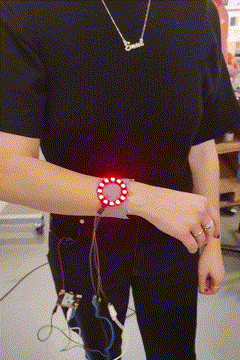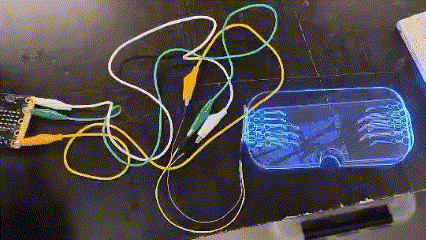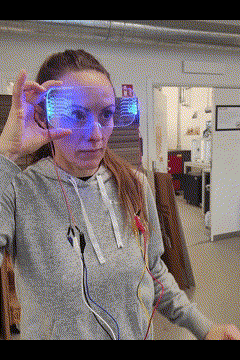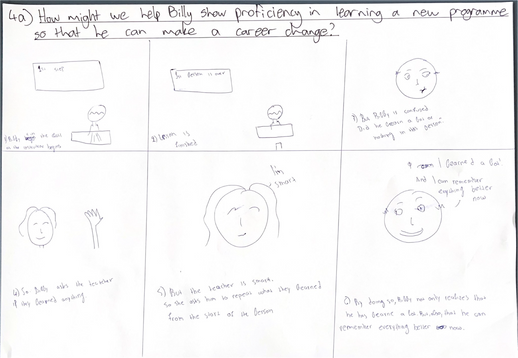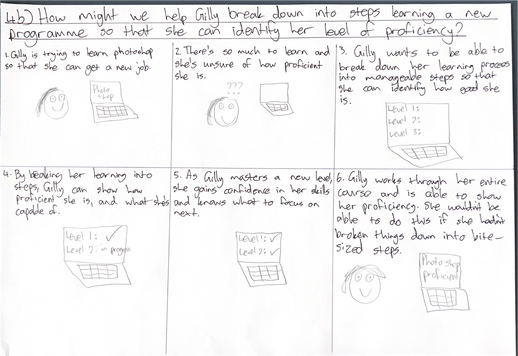
Welcome
In my current project, I am delving into the relationship between color and communication. I am specifically investigating how colors can be used to convey varying degrees of nonverbal communication in design. Through this exploration, I hope to uncover new ways to utilize color in wearable technology and other design applications.
The Future
A more in depth exploration
The prototype could be further developed to explore more intricate facets of human interaction by including additional sensory inputs like facial recognition and heart rate monitoring. This would enable a deeper understanding of human behavior and enhance the interactive experience.



Deliverable 4
Availability Glasses
After conducting user testing in Deliverable 3 and exploring the use of color in communication, I continued to iterate on the design of my prototype. I created two pairs and tested the effect of opposite control, where one person controls the color of another's prototype, versus direct control, where the user controls the light variations themselves. I gathered useful feedback and suggestions, such as using the well-known Red, Orange, Green colors of traffic lights to convey availability rather than emotions. Availability can range from simply being available to talk to someone to indicating relationship status.

The effects of color
Can color change the mood?
Video Concept
A different Variation
Testing No.1
Opposite Control
Testing No.2
Assuming direct control
Principles and Light
Friend Alert
After conducting user testing on the wearable bracelet prototype, I discovered that it had multiple potential use cases. The LED sequence, which can be controlled by another person, includes three stages of communication: green, yellow, and red. The original idea behind the bracelet was to help protect and warn friends, particularly women, during potentially dangerous situations such as a date or meet-up with an unfamiliar person. Green indicates safety, yellow represents a small warning, and red signifies an immediate need for help.
However, users also identified other potential uses for the bracelet. For instance, it could be used to discreetly signal to parents or significant others to come pick someone up from a party if they're feeling bored or uncomfortable.
Concept Art
Other uses for LED communication
Exploring the intersection of wearable design, LED technology, and communication through color, I iterated on my concept and transformed it into a bracelet prototype. I asked myself: if not emotions, then what else could this technology communicate?



Deliverable 3
Glassy Feelings
I designed and developed a wearable prototype using laser cut plexiglass as eyewear, and connected it to one or two microbits, creating an LED display capable of displaying various colors to represent different emotions. Through testing, the dual light sources with varying combinations of emotions received positive feedback. How could I improve the design and functionality of this prototype for better practical use?

Is sowing worth pursuing?
In class, we were introduced to the art of sewing, specifically using conductive string and materials to connect circuitry. This sparked the idea of creating a wearable design that incorporates this technique.
How can I incorporate my new knowledge of sewing and conductive materials to create a wearable design that incorporates circuitry?

To code or not to code?
During our coding lessons, I was particularly drawn to the process of connecting a micro bit to an LED strip, which allowed us to create an array of changing colors. I found this concept to be very interesting and wanted to implement it into my own prototype. However, I also recognized the need to make it more compact and wearable for practical use.




Concept Art Created
I worked alone and came up with a concept for mood-reading glasses that use different colors to indicate different emotions: Red and Blue for mixed anger and depression, Red for anger, and Green for disgust.
Scenario's Made
How can we improve our ability to recognize each other's emotions and nonverbal cues, especially when we don't know each other well or someone is trying to conceal their feelings, as in my case where anger was a constant despite my effort to stay positive and help the team, or in another scenario where a boy attempted to flirt but failed due to uncertainty about the other person's interest?
Lesson's Learned
During the first week of our project, we had the opportunity to share our unique skills with one another and learn something new as a team. Mickey demonstrated her talent for Chinese tongue twisters, Matteo provided guitar lessons, and I showcased my make-up skills. As a group, we also tried our hand at the art of origami. However, it wasn't all smooth sailing. One notable side note was that I was attempting to quit smoking during this time, and my increasing frustration was starting to become noticeable to the rest of the team. It took a little while for my colleagues to realize what was going on, but eventually we were able to offer support and encouragement to help me through the process.
Tongue Twisters

Origami Challenges

Makeup Tutorial

Guitar Lessons







